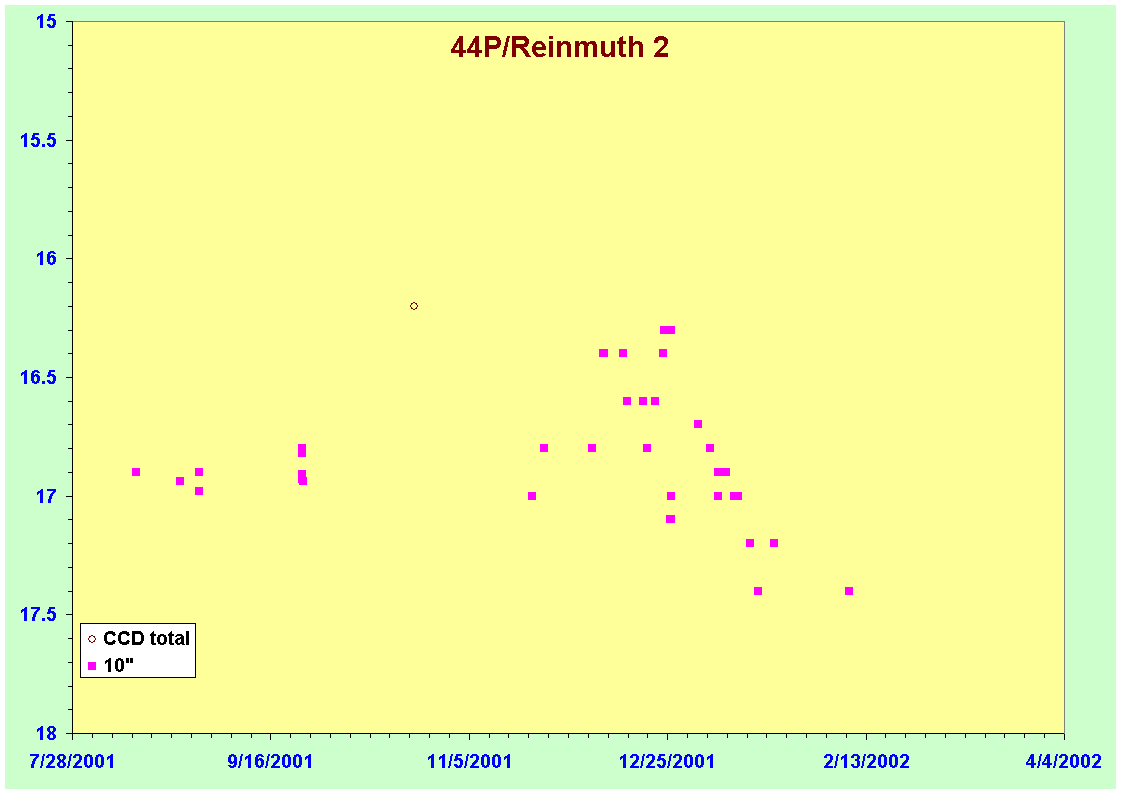44P/Reinmuth 2
44P/Reinmuth 2 was discovered by Karl Reinmuth
at Heidelberg on September 10th 1947 at magnitude 12.5. The comet was
discovered after perihelion and faded slowly. in less than 2 weeks Cunningham
had recognised that it was a short period comet. Various orbital solutions were
calculated estimating a period from 6.40 to 6.59 years. The longer period was
soon found to be the correct one. Since then it has been observed at nine
further returns (1954, 1960, 1967, 1974, 1981, 1988, 1994 and 2001) making the
current apparition its 9th observed apparition. However, it has never been
brighter than in its discovery apparition.
The comet is of short period. Initially the
period was 6.59 years and the perihelion distance 1.87AU, but both the period
and the perihelion distance increased slowly to 6.74 years and 1.95AU
respectively, before decreasing again to their current values of 6.63 years and
1.89AU - almost back to the discovery values. The comet had moderately close
approaches to Jupiter in 1943 and 1945 and its orbit is subject to continuous
small changes.
The 2001 apparition
 44P/Reinmuth 2 passed perihelion on
February 19th 2001, peaking at around magnitude 15.5. Like many old,
evolved comets it brightens rather rapidly as it approaches the Sun. In 1967 an
outburst was seen after perihelion. During the 2001/2002 a small outburst is
seen in December 2001. This is also recorded in Seichii Yoshida’s light curve of
the comet.
44P/Reinmuth 2 passed perihelion on
February 19th 2001, peaking at around magnitude 15.5. Like many old,
evolved comets it brightens rather rapidly as it approaches the Sun. In 1967 an
outburst was seen after perihelion. During the 2001/2002 a small outburst is
seen in December 2001. This is also recorded in Seichii Yoshida’s light curve of
the comet.
All the coverage in this light curve was taken between six and twelve months post-perihelion, during which period there is a good level of light curve coverage. The last observations recorded here were made in late January 2002.
The graph of
Afrho shows a rather flat activity  curve over the
post-perihelion period. Interestingly, the value of Afrho increased slowly from
20-cm to 30-cm between July and mid-December, before briefly bursting up to
40-cm in the second half of December. After the outburst the activity declined
rapidly.
curve over the
post-perihelion period. Interestingly, the value of Afrho increased slowly from
20-cm to 30-cm between July and mid-December, before briefly bursting up to
40-cm in the second half of December. After the outburst the activity declined
rapidly.
CCD observations in a 10 arcsecond aperture by:
- Pepe Manteca - MPC 170
- Ramón Naves & Montse Campàs - MPC 213
- Esteban Reina - MPC 232
CCD aperture photometry in apertures of 0'.2
and 0'.3 by:
- Giovanni Sostero
- Rolando Ligustri
- V.Savani
- M.Russiani
- M.Zorzeno
- G.Degano

Image: December 11th 2002
Image of
30P/Reinmuth. The sum of 10, 30s exposures. There is a very faint gas tail to
the right.l
++++++++++++++++++++++++++++++
Giovanni Sostero
Remanzacco Observatory (Italy)
Image: December 28th 2002
Image of 30P/Reinmuth showing the
faint tail.
++++++++++++++++++++++++++++++
Última actualización 23/01/2003
Por M.R.Kidger
Correo electrónico: mrk@iac.es